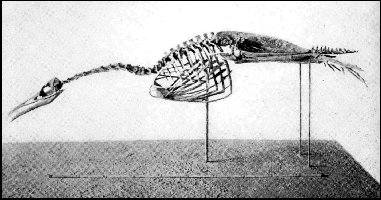
Hesperornis regalis Marsh 1872
Copyright © 2012-2014 by Mike Everhart
Page Created 07/22/2012; Last updated 01/19/2014
 |
Hesperornis regalis Marsh 1872 Copyright © 2012-2014 by Mike EverhartPage Created 07/22/2012; Last updated 01/19/2014
|
|
MEMOIRS OF THE
PEABODY MUSEUM OF YALE COLLEGE VOL. I ____________ ODONTORNITHES: A MONOGRAPH ON THE EXTINCT TOOTHED
BIRDS OF NORTH AMERICA WITH THIRTY-FOUR PLATES AND FORTY WOODCUTS BY OTHNIEL CHARLES MARSH Professor of Palæontology in Yale College ______________ NEW HAVEN, CONN. PRINTED FOR THE MUSEUM.
|
|
INTRODUCTION. ____________________________________________________________
1 |
|
2
ODONTORNITHES.
The geological horizon of the known Odontornithes is in the
Middle Cretaceous, and corresponds to the strata named by the writer the
"Pteranodon beds." The latter are included in sub-division
number three, in Meek and Hayden's section. The accompanying fossils are
Mosasauroid reptiles, which are very abundant; Plesiosaurs, allied to Pliosaurus;
Pterodactyles, of the genus Pteranodon; and many Fishes. With these
occur Rudistes, and occasionally Ammonites, Belemnites, and various other
Cretaceous invertebrates.
The first Bird fossil discovered in this region was the lower end
of the tibia of Hesperornis, found by the writer in December, 1870, near the Smoky·
Hill River in Western Kansas. Specimens belonging to another genus of the Odontornithes,
were discovered on the same expedition. The extreme cold, and danger from
hostile Indians, rendered a careful exploration at that time impossible. In June of the following year, the writer again visited the same region, with a larger party, and a stronger escort of United States troops, and was rewarded by the discovery of the skeleton which forms the type of Hesperornis regalis, Marsh. Various other remains of Odontornithes were secured, and have since been described by the writer. Although the fossils obtained during two months of exploration were important, the results of this trip did not equal our expectations, owing in part to the extreme heat (1100 to 1200 Fahrenheit, in the shade) which, causing sunstroke and fever, weakened and discouraged guides and explorers alike.
|
|
INTRODUCTION.
3
The specimens thus secured by these various expeditions have since
been supplemented by important additions, collected in the same general
region· by different parties equipped and sent out by the writer, who no
longer could give his personal supervision to work in that field. The
fossil Birds procured in this region since 1870, by these different
expeditions, include remains of more than one hundred different
individuals of the Odontornithes. These are all in the Museum of
Yale College, and form. the material on which the present volume is based.
A study of this extensive series of Bird remains brings to light
the existence in this class of two widely separated types, which lived
together during the Cretaceous period, in the same region, and yet
differed more . from each other than do any two recent birds. Both of
these types possessed teeth, a character hitherto unknown in the class of
Birds, and hence they have been placed by the' writer in a separate
sub-class, the Odontornithes. One of these groups includes very
large swimming birds, without wings, and with the teeth in grooves (Odontonithes),
and is represented by the genus Hesperornis. The other contains
small birds, endowed with great powers of flight, and having teeth in
sockets (Odontornithes), and biconcave vertebrae; a type best
illustrated by the genus Ichthyornis. Other characters, scarcely less important, appear in each group, and we have thus a vivid picture of two primitive forms of bird structure, as unexpected as they are suggestive. A comparison of these two forms with each other, and with some recent birds, promises to clear away many difficulties in the genealogy of this class, now a closed type; and hence they are well worthy of the detailed description and full illustration here devoted to them.
|
|
4
ODONTORNITHES. |
REFERENCES:
Marsh, O.C. 1872. Discovery of a remarkable fossil bird. American Journal of Science, Series 3, 3(13): 56-57.
Marsh, O.C. 1872. Preliminary description of Hesperornis regalis, with notices of four other new species of Cretaceous birds. American Journal of Science 3(17):360-365.
Marsh, O.C. 1873. Fossil birds from the Cretaceous of North America. American Journal of Science, Series 3, 5(27):229-231.
Marsh, O.C. 1875. On the Odontornithes, or birds with teeth. American Journal of Science, Series 3, 10(59):403-408, pl. 9-10.
Marsh, O.C. 1876. Notice of new Odontornithes. The American Journal of Science and Arts 11:509-511.
Marsh, O.C. 1877. Characters of the Odontornithes, with notice of a new allied genus. American Journal of Science 14:85-87, 1 fig. (Naming and description of Baptornis advenus)
Marsh, O.C. 1880. Odontornithes: A monograph on the extinct toothed birds of North America. U.S. Geol. Expl. 40th Parallel (King), vol. 7, xv + 201 p., 34 pl. (Synopsis of American Cretaceous birds, appendix 191-199)
Marsh, O.C. 1883. Birds with Teeth. 3rd Annual Report of the Secretary of the Interior, 3: 43-88. Government Printing Office, Washington, D.C.
Marsh, O.C. 1893. A new Cretaceous bird allied to Hesperornis. American Journal of Science 45:81-82.